
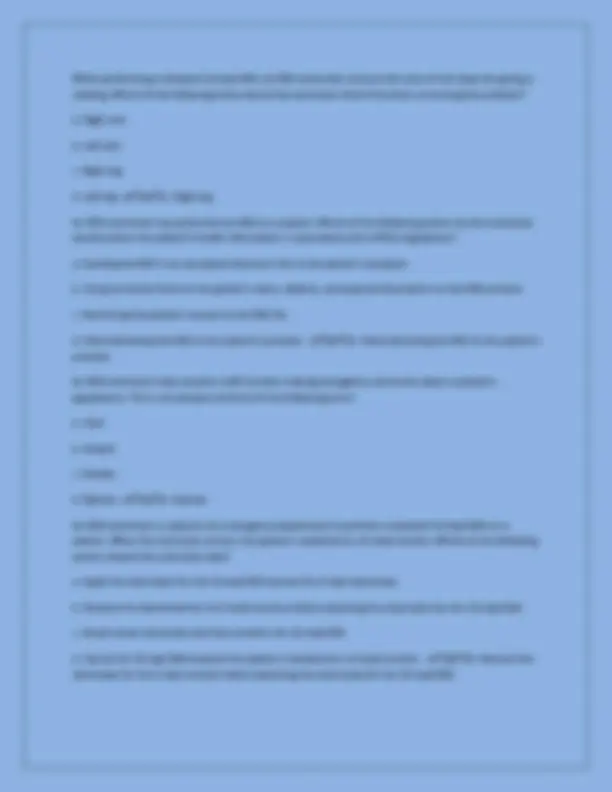
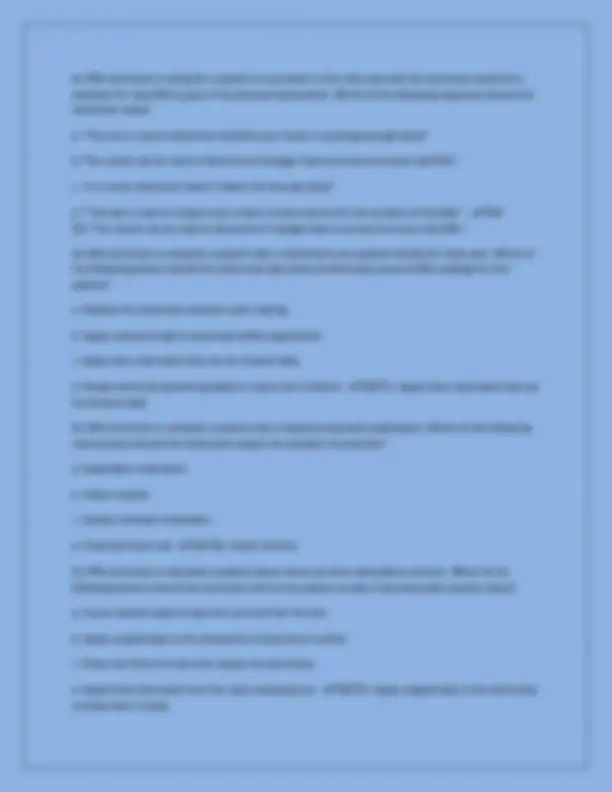
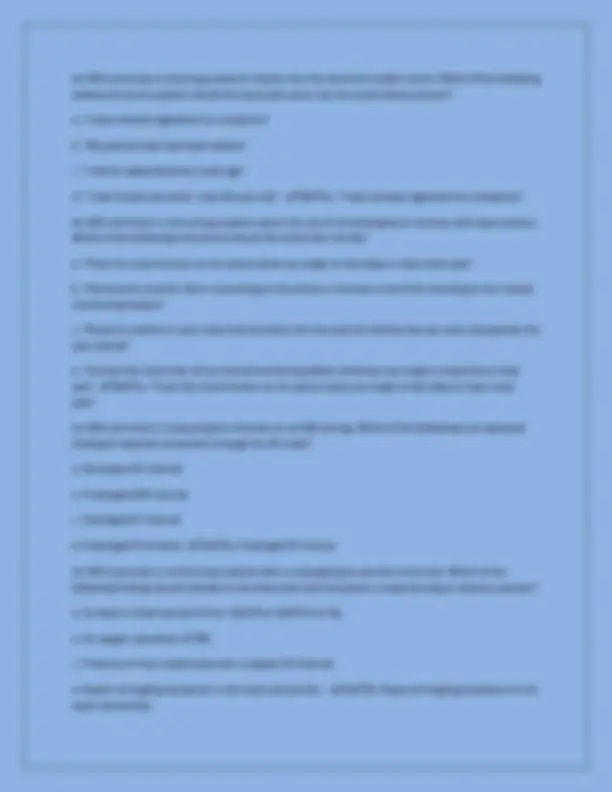
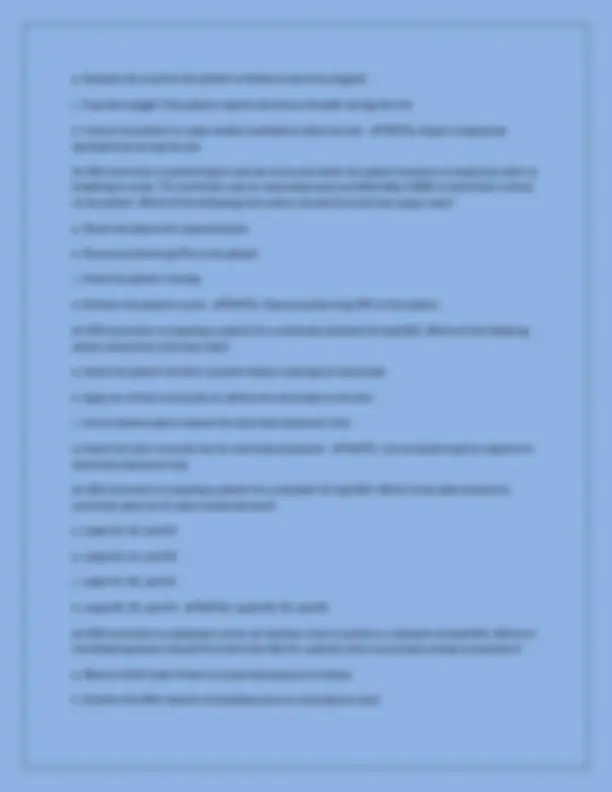
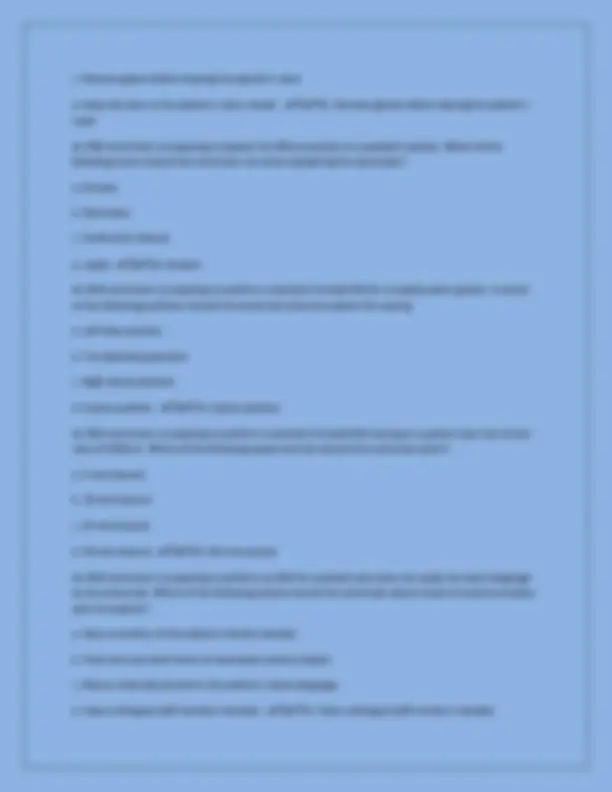
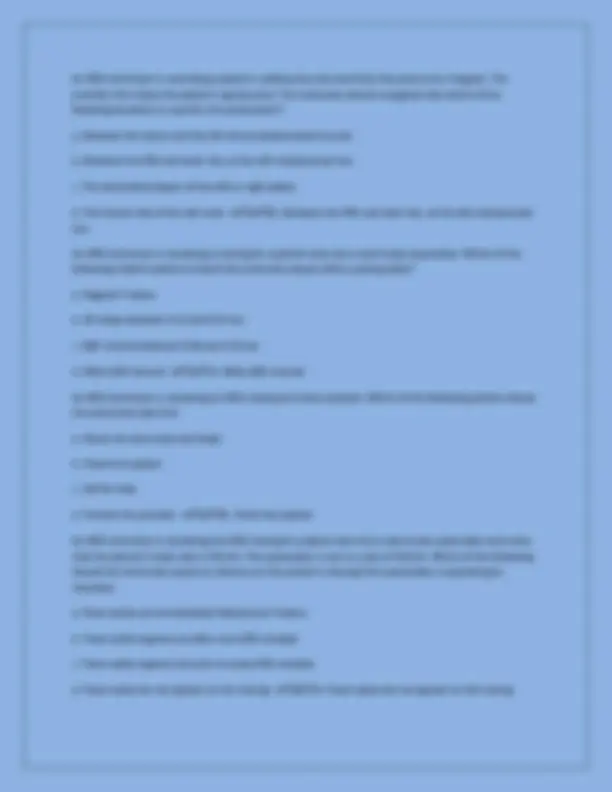
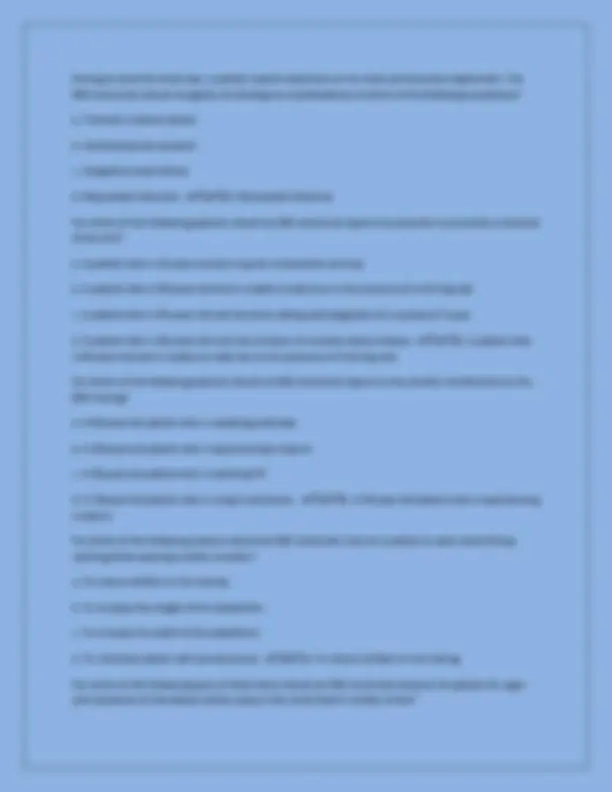
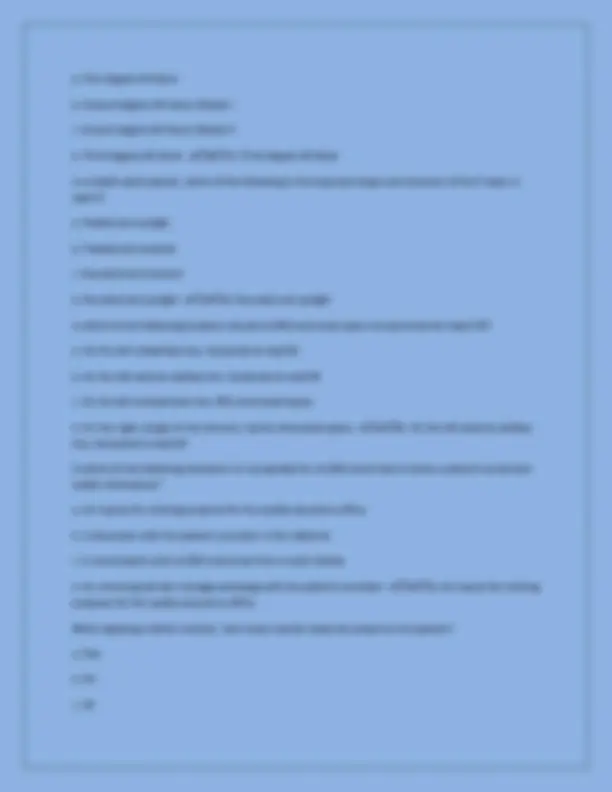
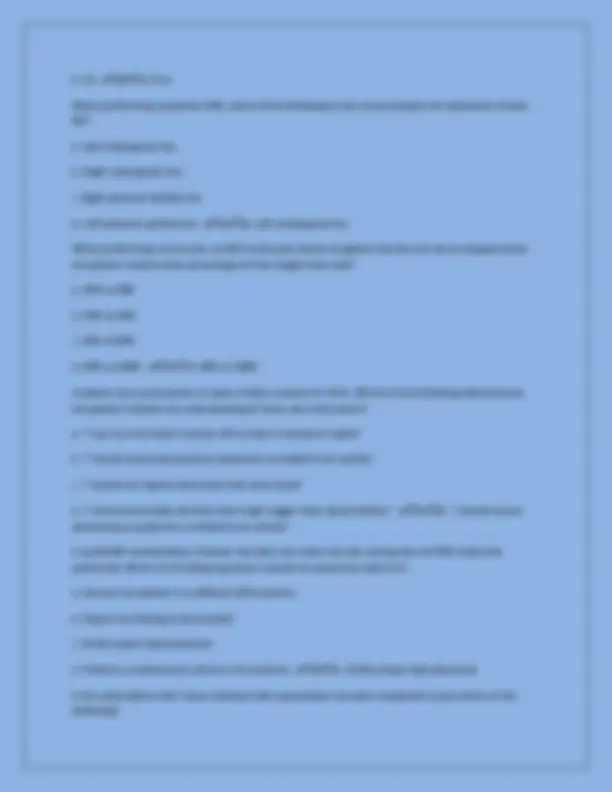
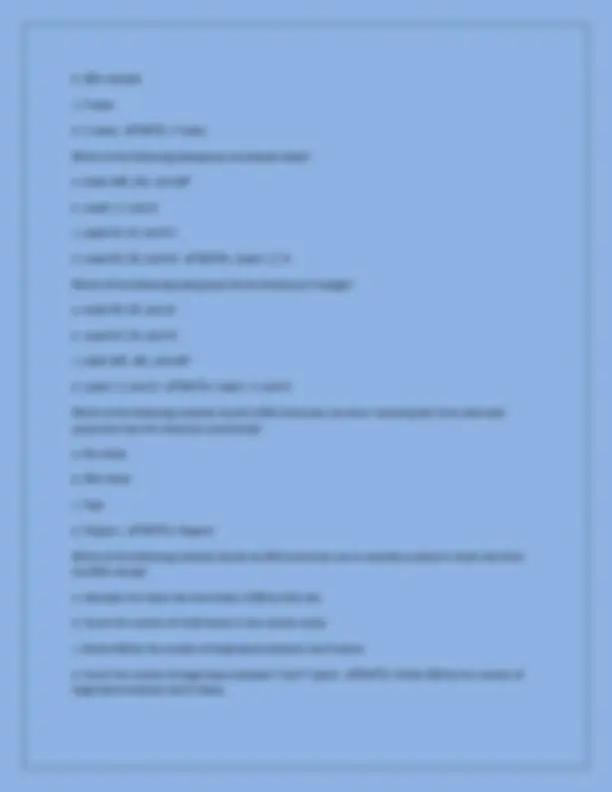
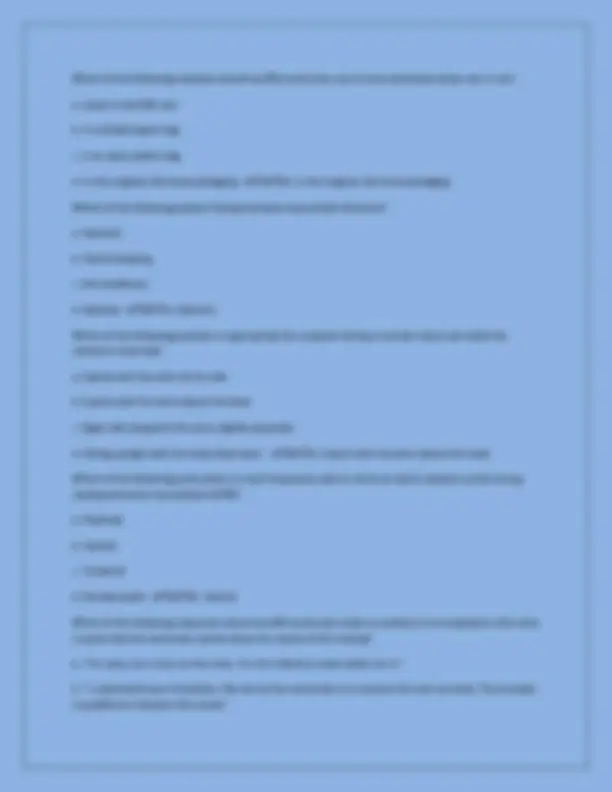
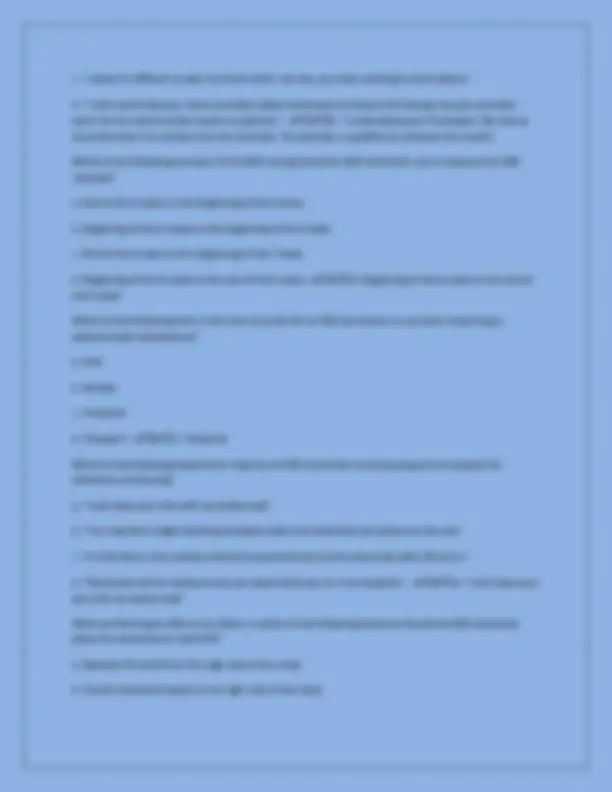
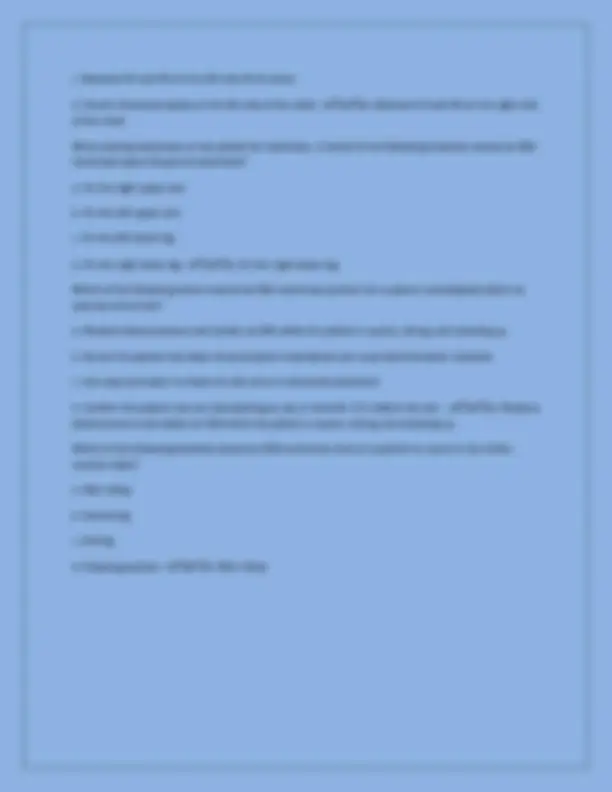


Study with the several resources on Docsity

Earn points by helping other students or get them with a premium plan


Prepare for your exams
Study with the several resources on Docsity

Earn points to download
Earn points by helping other students or get them with a premium plan
Community
Ask the community for help and clear up your study doubts
Discover the best universities in your country according to Docsity users
Free resources
Download our free guides on studying techniques, anxiety management strategies, and thesis advice from Docsity tutors
A comprehensive overview of the roles and responsibilities of an ekg technician in a healthcare setting. It covers a wide range of topics, including infection control practices, ekg interpretation, patient communication, and emergency procedures. The document delves into the specific steps and recommendations an ekg technician should follow when performing various tasks, such as preparing a patient for an ekg, interpreting ekg waveforms, and responding to patient emergencies. The level of detail and the breadth of the topics covered suggest that this document could be a valuable resource for ekg technicians, healthcare professionals, or students interested in the field of electrocardiography.
Typology: Exams
1 / 21

This page cannot be seen from the preview
Don't miss anything!














An EKG technician has a prescription to perform an EKG tracing on an older adult patient who is unconscious upon arrival at the emergency department. Which of the following actions should the technician take? a. Wait for the patient's adult child to arrive at the emergency department to obtain consent. b. Assume implied consent because the patient's condition is critical. c. Check the patient's insurance to ensure the EKG procedure is covered d. Wait for the provider to arrive before performing the EKG. - ✔ ✔ b. Assume implied consent An EKG technician should follow which of the following recommendations regarding infection control practices in health care settings? a. Artificial nails should be no longer than 1.27 cm (0.5 in) in length b. Use an alcohol-based hand rub if there is visible contamination on the hands. c. Remove soiled gloves prior to touching uncontaminated surfaces d. Wear the same gloves while performing different procedures on the same patient - ✔ ✔ c. Remove soiled gloves prior to touching uncontaminated surfaces An EKG technician should recognize that a PR interval that spans four small boxes on the EKG paper has which of the following durations? a. 0.08 seconds b. 0.12 seconds c. 0.16 seconds d. 0.2 seconds - ✔ ✔ c. 0.16 seconds An EKG technician should recognize that which of the following is characteristic of the EKG tracing for a patient who has atrial fibrillation? a. R-R interval is irregularly irregular b. Clearly defined T waves c. P-P interval occurs regularly d. Prolonged QRS duration - ✔ ✔ a. R-R interval is irregularly irregular
An EKG technician should recognize that which of the following is the most commonly used paper speed for an EKG? a. 5 mm/second b. 10 mm/second c. 25 mm/second d. 50 mm/second - ✔ ✔ c. 25 mm/secondbecause the patient's condition is critical.
Which of the following statements should an EKG technician include when preparing a patient for an upcoming exercise stress test? a. "Be sure to eat a light meal 6 to 8 hours prior to the test" b. "Wear tight clothing around your lower abdominal area so the electrodes stay in place." c. "Refrain from caffeine, smoking, or alcohol for at least 3 hours prior to the test." d. "The procedure should take about 10 to 15 minutes." - ✔ ✔ c. "Refrain from caffeine, smoking, or alcohol for at least 3 hours prior to the test." Which of the following vital sign changes during an exercise stress test should indicate to an EKG technician that an adult patient is experiencing distress? a. A decrease in temperature from 37.3° to 36.9°C (99.1° to 98.4°F) b. An increase in pulse rate from 76 to 84/min c. An increase in blood pressure from 120/80 to 128/84 mm HG d. An increase in respirations from 18 to 36/min - ✔ ✔ d. An increase in respirations from 18 to 36/min Which of the following waves should an EKG technician use to determine the regularity of the ventricular rate? a. U wave b. T wave c. R wave d. P wave - ✔ ✔ c. R wave
An EKG technician is caring for a patient in a provider's clinic who asks why the technician performs a standard 12- lead EKG as part of the physical examination. Which of the following responses should the technician make? a. "The test is used to determine whether your heart is receiving enough blood" b."The results can be used to determine if changes have occurred since your last EKG." c. "It is use to show your heart's rhythm for the past week" d. "This test is used to measure your heart's stroke volume for the duration of the EKG." - ✔ ✔ b."The results can be used to determine if changes have occurred since your last EKG." An EKG technician is caring for a patient who is admitted to an inpatient facility for chest pain. Which of the following actions should the technician take when performing a series of EKG readings for this patient? a. Replace the electrodes between each reading b. Apply conductive gel to electrodes before application c. Apply silver electrodes that can be checked daily d. Rotate electrode positioning daily to reduce skin irritation - ✔ ✔ c. Apply silver electrodes that can be checked daily An EKG technician is caring for a patient who is experiencing heart palpitations. Which of the following interventions should the technicians expect the provider to prescribe? a. Vasodilator medication b. Holter monitor c. Cardiac inotropic medication d. Chemical stress test - ✔ ✔ b. Holter monitor An EKG technician is education a patient about home use of an ambulatory monitor. Which of the following actions should the technician instruct the patient to take if any electrodes become loose? a. Use an alcohol swab to wipe dirt and oils from the skin b. Apply surgical tape to the electrodes to keep them in place c. Shave hair from the sites and replace the electrodes d. Apply fresh electrodes from the same manufacturer - ✔ ✔ b. Apply surgical tape to the electrodes to keep them in place
An EKG technician is entering a patient's history into the electronic health record. Which of the following statements by the patient should the technician enter into the social history section? a. "I have smoked cigarettes for a long time" b. "My parents both had heart attacks" c. "I had an appendectomy 1 year ago" d. "I had chicken pox when I was 10 years old" - ✔ ✔ a. "I have smoked cigarettes for a long time" An EKG technician is instructing a patient about the use of a transtelephonic monitor with loop memory. Which of the following instructions should the technician include? a. "Press the record button on the device when you begin to feel dizzy or have chest pain" b. "Remove the monitor when connecting to the phone or internet to send the recording to the central monitoring location" c. "Record a notation in your diary that describes the time and the activity that you were doing when the pain started" d. "Contact the technician at the central monitoring station whenever you begin to experience chest pain - ✔ ✔ a. "Press the record button on the device when you begin to feel dizzy or have chest pain" An EKG technician is measuring the intervals on an EKG tracing. Which of the following is an expected finding of impaired conduction through the AV node? a. Decreased QT interval b. Prolonged QRS interval c. Prolonged QT interval d. Prolonged PR interval - ✔ ✔ d. Prolonged PR interval An EKG technician is monitoring a patient who is undergoing an exercise stress test. Which of the following findings should indicate to the technician that the patient is experiencing an adverse reaction? a. Increase in blood pressure from 110/70 to 120/78 mm Hg b. An oxygen saturation of 95% c. Presence of sinus tachycardia with a regular R-R interval d. Report of tingling sensations in the lower extremities. - ✔ ✔ d. Report of tingling sensations in the lower extremities.
An EKG technician is performing a standard 12-lead EKG for an adult patient who is in the hospital. The patient becomes unresponsive, stops breathing, and does not have a pulse. Which of the following actions should be technician take first? a. Place the patient in the recovery position b. Start chest compressions c. Provide two breaths to the patient d. Retrieve the automated external defibrillator - ✔ ✔ b. Start chest compressions An EKG technician is performing a standard 12-lead EKG on a patient who is 4 years old. In which of the following locations should the technician place the V6 electrodes? a. Right midclavicular space b. Left midclavicular space c. Right midaxillary line d. Left midaxillary line - ✔ ✔ d. Left midaxillary line An EKG technician is performing a stress test for a patient. Which of the following EKG changes indicates that the patient is beginning to show signs of myocardial ischemia? a. PR interval of 0.16 seconds b. QRS complex of 0.10 seconds c. Depressed ST segment d. Presence of U wave - ✔ ✔ c. Depressed ST segment An EKG technician is performing an exercise stress test for a patient who exhibits ventricular fibrillation on the EKG tracing. Which of the following actions should the technician take first? a. Determine if the patient is responsive b. Check the patient for breathing c. Begin chest compressions d. Apply automated external defibrillator (AED) pads. - ✔ ✔ a. Determine if the patient is responsive An EKG technician is performing an exercise stress test to evaluate a patient for coronary vascular disease. Which of the following actions should technician take regarding this procedure? a. Report unexpected dysrhythmias during the test
b. Evaluate the need for the patient to follow an exercise program c. Prescribe oxygen if the patient reports shortness of breath during the test d. Instruct the patient to cease cardiac medications after the test - ✔ ✔ a. Report unexpected dysrhythmias during the test An EKG technician is performing an exercise stress test when the patient becomes unresponsive with no breathing or pulse. The technician uses an automated external defibrillator (AED) to administer a shock to the patient. Which of the following instructions should the technician expect next? a. Check the patient for responsiveness b. Resume performing CPR on the patient c. Check the patient's airway d. Monitor the patient's pulse - ✔ ✔ b. Resume performing CPR on the patient An EKG technician is preparing a patient for a scheduled standard 12-lead EKG. Which of the following actions should the technician take? a. Assist the patient into Sims' position before a placing the electrodes b. Apply an oil-free moisturizer to adhere the electrodes to the skin c. Use an alcohol pad to cleanse the electrode placement sites. d. Select the most muscular site for electrode placement - ✔ ✔ c. Use an alcohol pad to cleanse the electrode placement sites. An EKG technician is preparing a patient for a standard 12-lead EKG. Which three leads should the technician place at the same horizontal level? a. Leads V1, V2, and V b. Leads V2, V3, and V c. Leads V3. V4, and V d. Leads V4, V5, and V6 - ✔ ✔ d. Leads V4, V5, and V An EKG technician is preparing to enter an inpatient room to perform a standard 12-lead EKG. Which of the following actions should the technician take for a patient who is prescribed contact precautions? a. Wear an N-95 mask if there is a potential exposure to blood. b. Disinfect the EKG machine immediately prior to entering the room.
An EKG technician is recording a patient's radial pulse rate and finds the pulse to be irregular. The provider then takes the patient's apical pulse. The technician should recognize that which of the following locations is used for this assessment? a. Between the larynx and the left sternocleidomastoid muscle b. Between the fifth and sixth ribs, at the left midclavicular line c. The antecubital aspect of the left or right elbow d. The thumb side of the left wrist - ✔ ✔ b. Between the fifth and sixth ribs, at the left midclavicular line An EKG technician is reviewing a tracing for a patient who has a ventricular pacemaker. Which of the following rhythm patterns should the technician expect after a pacing spike? a. Regular P waves b. AV delay between 0.12 and 0.16 sec c. QRS interval between 0.06 and 0.10 sec d. Wide QRS interval - ✔ ✔ d. Wide QRS interval An EKG technician is reviewing an EKG tracing and notes asystole. Which of the following actions should the technician take first. a. Check the electrodes and leads b. Check the patient c. Call for help d. Contact the provider - ✔ ✔ b. Check the patient An EKG technician is reviewing the EKG tracing of a patient who has a ventricular pacemaker and notes that the patient's heart rate is 76/min. The pacemaker is set to a rate of 70/min. Which of the following should the technician expect to observe on the patient's tracing if the pacemaker is operating as intended. a. Pacer spikes are immediately followed by P waves. b. Pacer spikes appear just after ever QRS complex c .Pacer spikes appear just prior to every QRS complex d. Pacer spikes do not appear on the tracing - ✔ ✔ d. Pacer spikes do not appear on the tracing
An EKG technician is speaking with a patient on the phone. The patient is wearing a Holter monitor and reports severe chest pain and shortness of breath. Which of the following actions should the technician take? a. Have someone call emergency services while remaining on the call with the patient b. Remind the patient to document the incident in the patient diary. c. Place the patient on hold and consult with the patient's provider. d. Tell the patient to hang up the phone and call emergency services - ✔ ✔ a. Have someone call emergency services while remaining on the call with the patient An EKG technician is working with a patient who has a below-the-knee amputation of the left leg. In which of the following locations should the technician place the right leg electrode? a. On the lower right foot b. On the lower right abdomen c. On the lower left torso d. On the lower right leg - ✔ ✔ b. On the lower right abdomen An EKG technician notes a standard 12-lead EKG tracing shows an interrupted baseline. The technician knows that this artifact is most likely caused by which of the following? a. Improper skin preparation b. Patient tremors c. Improper grounding d. Lead corrosion - ✔ ✔ d. Lead corrosion An EKG technician notes periods of sinus arrest on a patient's EKG tracing. The technician should consider the sinus arrest to be a medical emergency when the arrest reaches which of the following durations? a. 6 sec b. 4 sec c. 3 sec d. 1 sec - ✔ ✔ a. 6 sec
During an exercise stress text, a patient reports heaviness on his chest and becomes diaphoretic. The EKG technician should recognize the findings as manifestations of which of the following conditions? a. Transient ischemic attack b. Cerebrovascular accident c. Congestive heart failure d. Myocardial infarction - ✔ ✔ d. Myocardial infarction For which of the following patients should an EKG technician expect the provider to prescribe a chemical stress test? a. A patient who is 35 years old and requires interpretive services b. A patient who is 40 years old and is unable to walk due to the presence of a full leg cast c. A patient who is 55 years old and has been talking anticoagulants for a period of 1 year d. A patient who is 60 years old and has a history of coronary artery disease - ✔ ✔ b. A patient who is 40 years old and is unable to walk due to the presence of a full leg cast For which of the following patients should an EKG technician expect to see somatic interference on the EKG tracing? a. A 60-year-old patient who is sweating profusely b. A 20-year-old patient who is experiencing a seizure c. A 10-year-old patient who is watching TV d. A 30-year-old patient who is using a cell phone. - ✔ ✔ b. A 20-year-old patient who is experiencing a seizure For which of the following reasons should an EKG technician instruct a patient to wear loose-fitting clothing while wearing a Holter monitor? a. To reduce artifact on the tracing b. To increase the height of the waveforms c. To increase the width of the waveforms d. To minimize patient self-consciousness - ✔ ✔ a. To reduce artifact on the tracing For which of the following types of heart block should an EKG technician observe the patient for signs and symptoms of decreased cardiac output that could lead to cardiac arrest?
a. First degree AV block b. Second-degree AV block, Mobitz I c. Second degree AV block, Mobitz II d. Third degree AV block - ✔ ✔ d. Third degree AV block In a health adult patient, which of the following is the expected shape and direction of the P wave in lead II? a. Peaked and upright b. Peaked and inverted c. Rounded and inverted d. Rounded and upright - ✔ ✔ d. Rounded and upright In which of the following locations should an EKG technician place the electrode for leavd V5? a. On the left midaxillary line, horizontal to lead V b. On the left anterior axillary line, horizontal to lead V c. On the left midclavicular line, fifth intercostal space d. On the right margin of the sternum, fourth intercostal space - ✔ ✔ b. On the left anterior axillary line, horizontal to lead V In which of the following situations is it acceptable for an EKG technician to share a patient's protected health information? a. An inquiry for training purposes for the quality assurance office. b. A discussion with the patient's provider in the cafeteria c. A conversation with an EKG technician from a sister facility d. An unencrypted text message exchange with the patient's provider - ✔ ✔ a. An inquiry for training purposes for the quality assurance office. When applying a Holter monitor, how many monitor leads are placed on the patient? a. Five b. Six c. 10
a. Atria b. Ventricles c. Early repolarization d. Late repolarization - ✔ ✔ a. Atria After completing a standard 12-lead EKG on a patient, which of the following actions should an EKG technician take next? a. Remove the electrodes and assist the patient to a sitting position b. Remove the EKG tracing from the machine and provide privacy for the patient to get dressed. c. Check that the tracing is free from artifacts and then disconnect the patient from the machine. d. Tell the patient that the test is complete and the provider will be in shortly - ✔ ✔ c. Check that the tracing is free from artifacts and then disconnect the patient from the machine. Which of the following arteries is the best location for an EKG technician to use to measure the heart rate for an adult patient following an exercise stress test? a. Radial b. Carotid c. Femoral d. Brachial - ✔ ✔ a. Radial Which of the following descries a complete cardiac cycle in a healthy heart? a. P wave, Q wave, and ST segment b. P wave, QRS complex, and T wave c. P wave, QRS complex, and QT interval d. P wave, QRS complex, and P wave - ✔ ✔ b. P wave, QRS complex, and T wave Which of the following EKG machine functions should an EKG technician use to control and regulate the height of EKG waveforms on the tracing? a. Speed b. Output display c. Artifact filter
d. Gain - ✔ ✔ d. Gain Which of the following factors can produce an artifact that appears as uniform. small spikes on an EKG tracing? a. Corroded leads b. Improper grounding c. Poor skin preparation d. Patient movement - ✔ ✔ b. Improper grounding Which of the following findings is consistent with bradycardia? a. Hyperventilation b. Blood pressure of 100/80 mm Hg c. Cold and clammy skin d. Pulse rate of 140/min - ✔ ✔ c. Cold and clammy skin Which of the following is cause for discontinuing a stress test? a. Increased diaphoresis b. Shortened PR interval c. Increased heart rate d. ST segment elevation - ✔ ✔ d. ST segment elevation Which of the following is the most effective technique for an EKG technician to use to verify that a patient understands the Holter monitor instructions? a. Ask the patient if they understand the instructions b. Have the patient repeat the instructions back c. Watch the patient for signs of understanding d. Have the patient complete a test about the instructions - ✔ ✔ b. Have the patient repeat the instructions back Which of the following is the result of atrial depolarization? a. T wave
Which of the following methods should an EKG technician use to store electrodes when not in use? a. Loose in the EKG cart b. In a folded paper bag c. In an open plastic bag d. In the original, foil-lined packaging - ✔ ✔ d. In the original, foil-lined packaging Which of the following patient finding indicates myocardial infarction? a. Cyanosis b. Facial drooping c. Arm weakness d. Aphasia - ✔ ✔ a. Cyanosis Which of the following positions is appropriate for a patient during a nuclear stress test while the camera is scanning? a. Supine with the arms at the side b. Supine with the arms above the head c. Right-side lying with the arms slightly extended d. Sitting upright with the head tilted back. - ✔ ✔ b. Supine with the arms above the head Which of the following pulse points is most frequently used to check an adult's patient's pulse during cardiopulmonary resuscitation (CPR)? a. Popliteal b. Carotid c. Temporal d. Dorsalis pedis - ✔ ✔ b. Carotid Which of the following responses should an EKG technician make to a patient in an outpatient clinic who is upset that the technician cannot share the results of the tracing? a. "I'm sorry, but I only run the strip. I'm not trained to know what's on it." b. "I understand your frustration. My role as the technician is to conduct the test correctly. The provider is qualifies to interpret the results"
c. "I know it's difficult to wait, but from what I can see, you have nothing to worry about." d. "I wish could help you. Some providers allow technicians to discuss the tracing, but your provider won't let me communicate results to patients." - ✔ ✔ b. "I understand your frustration. My role as the technician is to conduct the test correctly. The provider is qualifies to interpret the results" Which of the following sections of the EKG tracing should an EKG technician use to measure the QRS complex? a. End of the Q wave to the beginning of the S wave b. Beginning of the Q wave to the beginning of the S wave c. End of the Q wave to the beginning of the T wave d. Beginning of the Q wave to the end of the S wave - ✔ ✔ d. Beginning of the Q wave to the end of the S wave Which of the following sites is the most accurate for an EKG technician to use when measuring a patients body temperature? a. Oral b. Axillary c. Temporal d. Tympanic - ✔ ✔ c. Temporal Which of the following statements made by an EKG technician correctly prepares the patient for telemetry monitoring? a. "I will clean your skin with an alcohol pad" b. "You may feel a slight warming sensation after the electrodes are placed on the skin" c. "A mild rash or skin redness should be expected around the electrodes after 24 hours." d. "Electrodes will be replaced once per week while you're in the hospital." - ✔ ✔ a. "I will clean your skin with an alcohol pad" When performing an EKG on an infant, in which of the following locations should the EKG technician place the electrode for lead V3R? a. Between V2 and V4 on the right side of the chest b. Fourth intercostal space on the right side of the chest